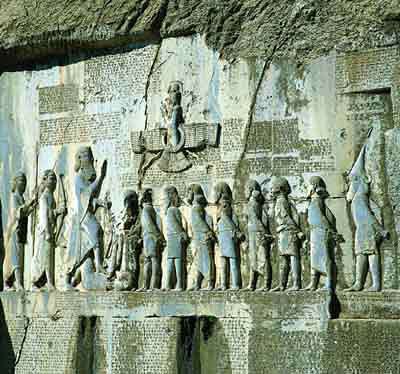Islamic Historians
Islamic Historians
The histories of what’s come to be known as South Caucasus, Armenia and Iran have been closely interrelated since the earliest periods of recorded history. The Iranian Median Empire posed serious threats to the Armenian kingdom of Van. According to Movses Khorenatsi, the Armenian king Tigran Yervandian (Orontid, ruled around 560–535 BC) helped Cyrus II (the Great) in overthrowing the Median king Astyages (Ajdahak) and establishing the Achaemenids. Of course, later on Cyrus annexed Armenia to his empire. Darius the Great (522-486 BC) also attacked Armenia and as stated by his trilingual inscription in Baghastana (Bistoon, Behistun), near Kermanshah, where he calls Armenia: Armina in Old Persian, Harmina in Elamite and Urashtu (Urartu) in Akkadian, he admits he had to fight five times to suppress the rebellious Armenians to subjugate them.
Darius’ inscription Baghastana (Bistoon, Behistun)
The history of Armenia remained related to Iran after the Arab invasion as well. The Arab conquest which also included both countries meant that the Islamic historians couldn’t overlook the events in Armenia. A considerable number of these are Iranian in origin but since for the first couple of centuries of the Islamic era, Arabic was imposed as the written language in the already Islamized Iran, the Iranian scientists, philosophers, travelers, geographers, historians, etc., have written in Arabic.
Aghvank and Azarbaijan (Atrpatakan) have always been referred to as separate entities by all Islamic historians. It’s true that at times, they have been put under the same administrative region but even then they were still considered two different lands. The same thing has also happened to Armenia, where sometimes a part of it has come under the administration of Aghvank and vice versa.
In any case, the interesting thing about the accounts of the Islamic historians is that almost all of them consider Aghvank (Aran or Ar Ran in Arabic) a part of Armenia, a point that they report as a most normal and ordinary truth, regardless whether, for instance, Artsakh was put under the administration of Aghvank or otherwise.
This is not good for the “Azeris” who claim to be the descendants of the Aghvans (among all other nations of the region and beyond), who they always refer to with the fallacious terms “Albanians” for the people and “Albania” for their country, the mistaken transliterations of some European historians. “Azeri” distorians who deny the existence of Armenia simply project their deficiencies on Armenians because examining every surviving historical document one will be wasting their time looking for a single mention of “Azeri” as a nation or “Azerbaijan” in the Caucasus whereas all historians who have written about the region, have reported extensively concerning Armenia and Armenians.


0 Comments:
Post a Comment
<< Home